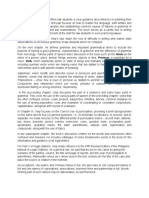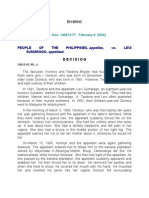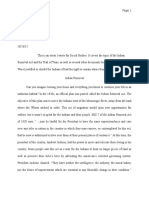Proposal - Legal Research
Proposal - Legal Research
Uploaded by
Neva Bersamen BenitoCopyright:
Available Formats
Proposal - Legal Research
Proposal - Legal Research
Uploaded by
Neva Bersamen BenitoOriginal Title
Copyright
Available Formats
Share this document
Did you find this document useful?
Is this content inappropriate?
Copyright:
Available Formats
Proposal - Legal Research
Proposal - Legal Research
Uploaded by
Neva Bersamen BenitoCopyright:
Available Formats
A Research Proposal In Legal Research
The Continuing Plight of the Bogobos in Bansalan: A Struggle for Land and Life
In Partial Fulfillment of Ll ____
Submitted to: Atty. Pilariza Racho-Baldovino
Submitted by: Benito, Neva Bersamen Caraoa, Ma. Erwynnah Lopez, Eva Cajes, Nancy Sayson, Eliezer
The Continuing Plight of the Bogobos in Bansalan: A Struggle for Land and Life
Duration of the Project: This proposal is aimed to be finished within three (3) weeks. Due to the distance of the proponents house and since most are working, each proponent agreed to contribute a little every Proponents: This proposal is a hardwork of five (5) first year law school students in Cor Jesu, Digos City, to wit: Author: Co-Author: Contributors: Eliezer Sayson Ma. Erwynnah Caraoa Neva Bersamen-Benito Nancy Cajes Eva T.Lopez Objectives: General Objective: To make an assessment as to the efficacy and responsiveness of IPRA in drawing up and furthering plans and programs under the auspices of the National Commission on Indigenous Peoples (NCIP) with the Bagobos in Bansalan, Davao del Sur. Specific Objectives: a. To assess how far the law has gone in its implementation to protect and promote the rights and cultures of the Bagobos in Bansalan, Davao del Sur. b. To know if the Bagobos in Bansalan, Davao del Sur have a full grasp and understanding of the provisions of the Indigenous Peoples Rights Act (RA 8371).
c. To identify problems in awarding rights and ownership of lands to Bogobos in Bansalan.
Background of the Research: RA 8371 is the most silent ____ever as its implementation and The proponents were driven to focus their study about the plight of the indigenous people because the proponents considered them as the most vulnerable people in the country today because of their socio-economic status. On the other hand, proponents wanted to know how far has the government ____their right to their ancestral land, their right to preserve their culture and tradition. With the mining act which was _____ by Pres. Gloria Macapagal Arroyo recently, most of the indigenous people especially here in Mindanao were the victims of such mining act.
METHODOLOGY Research Design: Qualitative Research Locale The study will be conducted in Sampling Research Instruments
Review of Related Literature
The National Commission on Indigenous Peoples has been rendered almost useless because of lack of resources. In Misamis Oriental alone, there are about 50 ancestral domain claims and only 1 has been given a certificate of ancestral domain title or the CADT. I heard that they have a target to issue 1 CADT per year. At this rate, all the Claims will be finished in 50 years, at this rate the claimants are already dead before they are given the title. (Coffee Writings, 2008)
The lack of awareness of IPRA is traceable to the lack of information dissemination on this legislation in the study sites by the National Commission for Indigenous Peoples, the provincial lead agency for indigenous peoples, and to the absence of Subanen organization in the area. (Gomez &Roxas, 2009)
Among lumad groups present in almost all total 67 municipalities in Caraga, the Manobo, Mamanwa, and Higaonon ethnic groups were dominant but their numbers are dwindling especially the Mamanwas (Negrito-like) due to extreme poverty which make them susceptible, exposed to all kinds of illnesses. Because they are among the most neglected, marginalized sector, majority of Mamanwa tribesmen were unschooled therefore exposed to various human rights violations and abuses. (Serrano, 2008)
The passage of the Indigenous Peoples Rights Act of 1997 (IPRA) was intended to herald a new era in the respect and recognition of the much-neglected rights of indigenous peoples in the country. However, barely a year since its promulgation, it has already met with stiff opposition from a well-respected former Supreme Court Justice. This eventually resulted in the case of Cruz vs DENR Secretary, a modern day jurisprudential cliffhanger that barely upheld the IPRAs validity after the Supreme Court en banc could not break its voting deadlock. (Ateneo Law Journal, 2002)
You might also like
- Civil Pro 2 Cases 1-3Document14 pagesCivil Pro 2 Cases 1-3Ralph Ryan TooNo ratings yet
- A Experiência Zapatista Rebeldia, Resistência, Autonomia (Jérôme Baschet)Document384 pagesA Experiência Zapatista Rebeldia, Resistência, Autonomia (Jérôme Baschet)dolorescristina100% (1)
- ccdn412 Project 1 Decolonisation - Arcadia Branded Tea - Joyce Kim 200494771Document3 pagesccdn412 Project 1 Decolonisation - Arcadia Branded Tea - Joyce Kim 200494771api-269292118No ratings yet
- The Equal Protection Clause: Case FactsDocument31 pagesThe Equal Protection Clause: Case FactsKazzy GNo ratings yet
- The Idea of Indigenous PeopleDocument7 pagesThe Idea of Indigenous PeopleShah KamaruzamanNo ratings yet
- ULEP SummaryDocument2 pagesULEP SummaryKatherine Mae Bautista-Perez100% (1)
- 146 SCRA 446 Tanada Vs TuveraDocument4 pages146 SCRA 446 Tanada Vs TuveraAllen SoNo ratings yet
- Legal MemorandumDocument6 pagesLegal MemorandumHuzaimar Anjalin100% (3)
- Cta Eb CV 01174 D 2016mar03 AssDocument22 pagesCta Eb CV 01174 D 2016mar03 Assedwin malipayonNo ratings yet
- MacamvmacamDocument3 pagesMacamvmacamFred Michael L. GoNo ratings yet
- People v. PringasDocument3 pagesPeople v. PringasJackie CanlasNo ratings yet
- CASTILLO, Gilbert S.: PRO VersionDocument5 pagesCASTILLO, Gilbert S.: PRO VersionIpahNo ratings yet
- ResolutionDocument7 pagesResolutionMaanNo ratings yet
- Impeachment Complaint vs. SC CJ Renato CoronaDocument70 pagesImpeachment Complaint vs. SC CJ Renato CoronaImperator FuriosaNo ratings yet
- Legal MemorandumDocument6 pagesLegal MemorandumKenneth Buñag100% (1)
- Filipino First Policy EnshrinedDocument24 pagesFilipino First Policy EnshrinedJANNNo ratings yet
- Bar Examination 2005 Q&ADocument20 pagesBar Examination 2005 Q&ADianne Esidera Rosales100% (1)
- Bote NotesDocument45 pagesBote NotesSuiNo ratings yet
- Case Digest: Mendoza - y - Bucad - v. - People20230221Document14 pagesCase Digest: Mendoza - y - Bucad - v. - People20230221Mae DesdirNo ratings yet
- Jason Ivler Aguilar Case, Double Jeopardy, Criminal Law 2, Book 2, Reckless ImprudenceDocument1 pageJason Ivler Aguilar Case, Double Jeopardy, Criminal Law 2, Book 2, Reckless ImprudenceKris CaraanNo ratings yet
- People Vs Sumarago - RapeDocument16 pagesPeople Vs Sumarago - Rapegeorjalynjoy100% (1)
- Interoffice MemorandumDocument3 pagesInteroffice MemorandumRoe Dee100% (1)
- Constitutional Law2 Lagcao Vs Judge Labra GR No 155746 January 30, 2020 CASE DIGESTDocument3 pagesConstitutional Law2 Lagcao Vs Judge Labra GR No 155746 January 30, 2020 CASE DIGESTBrenda de la GenteNo ratings yet
- Complaint To RTCDocument2 pagesComplaint To RTCBryan Vince LeeNo ratings yet
- Contracts Pointers 1Document16 pagesContracts Pointers 1Daniel Kristoffer Saclolo OcampoNo ratings yet
- People V GaliciaDocument3 pagesPeople V GaliciaStephanie TumulakNo ratings yet
- Third Division: Nilo Maghilum Y Portacion, Petitioner, vs. People of THE PHILIPPINES, RespondentDocument3 pagesThird Division: Nilo Maghilum Y Portacion, Petitioner, vs. People of THE PHILIPPINES, RespondentAyen Rodriguez MagnayeNo ratings yet
- Case Digest 20 22Document3 pagesCase Digest 20 22Josephine Redulla LogroñoNo ratings yet
- Cyber Crime Elements and Dio CaseDocument20 pagesCyber Crime Elements and Dio CaseDanielle Nicole ValerosNo ratings yet
- PFR CasesDocument7 pagesPFR Casespatricia.aniyaNo ratings yet
- Caras Vs CADocument2 pagesCaras Vs CADayday AbleNo ratings yet
- 210 Catubao vs. Sandiganbayan, G.R. No. 227371, October 02, 2019Document2 pages210 Catubao vs. Sandiganbayan, G.R. No. 227371, October 02, 2019Charles BayNo ratings yet
- Ricafort vs. BansilDocument1 pageRicafort vs. BansilDyane Garcia-AbayaNo ratings yet
- Delito ContinuadoDocument1 pageDelito ContinuadoPons Mac PacienteNo ratings yet
- People vs. Chua HiongDocument2 pagesPeople vs. Chua HiongAlfonso Miguel DimlaNo ratings yet
- Roy III Vs Herbosa Digest PDF FreeDocument3 pagesRoy III Vs Herbosa Digest PDF FreeajdgafjsdgaNo ratings yet
- Persons & Family Relations Compilation of Bigamy CasesDocument27 pagesPersons & Family Relations Compilation of Bigamy CasesNikki AndradeNo ratings yet
- Indomitable Rene To New LawyersDocument7 pagesIndomitable Rene To New LawyersReynald CruzNo ratings yet
- What Exactly Is Teaching Law in The Grand Manner (Agabin)Document26 pagesWhat Exactly Is Teaching Law in The Grand Manner (Agabin)Cathy BelgiraNo ratings yet
- Regal Films vs. Concepcion G.R. 139532Document4 pagesRegal Films vs. Concepcion G.R. 139532jackNo ratings yet
- BAR Q and A Property RegimesDocument9 pagesBAR Q and A Property RegimesjoyeduardoNo ratings yet
- 100 Bar Examination Questions For Political LawDocument18 pages100 Bar Examination Questions For Political LawKrizza Joy MadridNo ratings yet
- G.R. No. L-22526 November 29, 1966Document2 pagesG.R. No. L-22526 November 29, 1966Artjane Erica MolinaNo ratings yet
- Doctrine of Procedural VoidDocument2 pagesDoctrine of Procedural Voidcehuonlicae100% (1)
- Ejection ComplaintDocument4 pagesEjection ComplaintYakisoba RamenNo ratings yet
- Complaint For Acts of Lasciviousness Sample FormatDocument1 pageComplaint For Acts of Lasciviousness Sample Formatmegzycutes3871100% (1)
- HEIRS OF DOMINADOR S. ASIS, JR Vs GG Sportswear Manufacturing CorporationDocument2 pagesHEIRS OF DOMINADOR S. ASIS, JR Vs GG Sportswear Manufacturing CorporationRizza Angela MangallenoNo ratings yet
- CASE #19 Consolacion P. Chavez, Et - Al. Vs Maybank Philippines, Inc. G.R. No. 242852, July 29, 2019 FactsDocument1 pageCASE #19 Consolacion P. Chavez, Et - Al. Vs Maybank Philippines, Inc. G.R. No. 242852, July 29, 2019 FactsHarlene HemorNo ratings yet
- Pre Trial Trial - Dean Ferdinand A. TanDocument13 pagesPre Trial Trial - Dean Ferdinand A. TanDax MonteclarNo ratings yet
- Skinner v. OklahomaDocument13 pagesSkinner v. OklahomaLinda RobertNo ratings yet
- In Partial Fulfillment of The Requirements in Criminal Law IIDocument4 pagesIn Partial Fulfillment of The Requirements in Criminal Law IIMaria Resper LagasNo ratings yet
- Crespo v. MogulDocument3 pagesCrespo v. MogulJNo ratings yet
- Search of Moving VehicleDocument1 pageSearch of Moving VehicleVauge Jill Loontey0% (1)
- Legal OpinionDocument2 pagesLegal OpinionDayanski B-m100% (1)
- Tan vs. Nitafan 231 SCRA 129, March 11, 1994Document21 pagesTan vs. Nitafan 231 SCRA 129, March 11, 1994MarkNo ratings yet
- People v. BanihitDocument1 pagePeople v. BanihitLyleThereseNo ratings yet
- Awareness of The Most Populated Pala-Oan and Tagbanua Tribein Narra Palawan On The Indigenous People Rights Act (Republic Act No.8371) in Relation To Some VariablesDocument67 pagesAwareness of The Most Populated Pala-Oan and Tagbanua Tribein Narra Palawan On The Indigenous People Rights Act (Republic Act No.8371) in Relation To Some Variablespia padilla100% (1)
- Envi-Free and Prior Consent in The Tagbanua of Coron IslandDocument26 pagesEnvi-Free and Prior Consent in The Tagbanua of Coron IslandSui100% (2)
- Jan Lloyd Pating Indigenous People Their Lands and FutureDocument2 pagesJan Lloyd Pating Indigenous People Their Lands and FutureDick Jefferson Ocampo PatingNo ratings yet
- 2015 Artículo Original - Problemas Éticos en Poblaciones IndígenasDocument6 pages2015 Artículo Original - Problemas Éticos en Poblaciones IndígenasYesenia Sandoval GomezNo ratings yet
- Compilation of Agusanon Manobo Customary Laws A Secondary ResearchDocument29 pagesCompilation of Agusanon Manobo Customary Laws A Secondary ResearchMae Niagara100% (1)
- CARNEIRO DA CUNHA, M e ALMEIDA, M. Indigenous People, Traditional People and Conservation in The AmazonDocument25 pagesCARNEIRO DA CUNHA, M e ALMEIDA, M. Indigenous People, Traditional People and Conservation in The AmazonLuísa GirardiNo ratings yet
- Hau7 3 013Document25 pagesHau7 3 013KLEIN DUARTENo ratings yet
- Koppen Brazilian MunicipalitiesDocument375 pagesKoppen Brazilian MunicipalitiesRodrigo HamziNo ratings yet
- Annotated BibliographyDocument3 pagesAnnotated Bibliographyoli98987No ratings yet
- Arbol NyhrmcDocument1 pageArbol NyhrmcJosé Ricardo Pinto RiveraNo ratings yet
- Finalsample 1Document6 pagesFinalsample 1api-447068134No ratings yet
- Tribal Demography in IndiaDocument183 pagesTribal Demography in Indiavijaykumarmv100% (1)
- Top 10 Languages Used in The PhilippinesDocument6 pagesTop 10 Languages Used in The PhilippinesmelabbyhahaNo ratings yet
- History of The Quichua of Santiago Del EsteroDocument21 pagesHistory of The Quichua of Santiago Del EsteroAdilq TucumanNo ratings yet
- Hmar People's Convention - DemocracyDocument8 pagesHmar People's Convention - DemocracyHmar100% (1)
- History of Spanish Slavery in The Philippines - Wikipedia PDFDocument20 pagesHistory of Spanish Slavery in The Philippines - Wikipedia PDFAngelica VillorenteNo ratings yet
- North Eastern HistoryDocument27 pagesNorth Eastern HistoryPakmikamki0% (1)
- Tyranny of NumbersDocument15 pagesTyranny of NumberskassychNo ratings yet
- Nilliajut: Inuit Perspectives On Security, Patriotism and SovereigntyDocument76 pagesNilliajut: Inuit Perspectives On Security, Patriotism and SovereigntyOpen Briefing100% (1)
- Final Amc IndigenousnationmovementDocument1 pageFinal Amc IndigenousnationmovementDoug ThomasNo ratings yet
- FANA Public NoticeDocument2 pagesFANA Public NoticeMashapaug Nahaganset TribeNo ratings yet
- Lecture Notes For A History of KenyaDocument10 pagesLecture Notes For A History of KenyaSaina KennethNo ratings yet
- Sou TH Amer Ica: Area Population Pop. DensityDocument12 pagesSou TH Amer Ica: Area Population Pop. Densityyash100% (1)
- Kitzhaber v. Captain PetitionerBrief SCOTUS11-0274Document35 pagesKitzhaber v. Captain PetitionerBrief SCOTUS11-0274tbmaugNo ratings yet
- Aimé Césaire GuideDocument15 pagesAimé Césaire GuidecjlassNo ratings yet
- Indigenous Governance Structures in The Southwest of Western AustraliaDocument20 pagesIndigenous Governance Structures in The Southwest of Western AustraliaManuhuia BarchamNo ratings yet
- Lawsuit Claims Land in Northern Alberta and Saskatchewan Owed To MetisDocument31 pagesLawsuit Claims Land in Northern Alberta and Saskatchewan Owed To MetisDavid A. Giles100% (1)
- Guam History Day Process PaperDocument8 pagesGuam History Day Process PaperAlfonso GarciaNo ratings yet
- Taikaha Briefing Paper - Norway Delegation - May2015Document12 pagesTaikaha Briefing Paper - Norway Delegation - May2015Catherine Murupaenga-IkennNo ratings yet
- Indian Removal EssayDocument4 pagesIndian Removal Essayapi-319006552No ratings yet
- Preserving Culture and HeritageDocument3 pagesPreserving Culture and HeritageRNJNo ratings yet
- Marma in BangladeshDocument22 pagesMarma in BangladeshRakhine Students' Education FundNo ratings yet
- Emc18 ProgramDocument3 pagesEmc18 ProgramSebastián BarragánNo ratings yet
- Trail of Tears Worksheet 1Document2 pagesTrail of Tears Worksheet 1api-292196043No ratings yet

























































































